JEEP WRANGLER 2015 JK / 3.G Owners Manual
Manufacturer: JEEP, Model Year: 2015, Model line: WRANGLER, Model: JEEP WRANGLER 2015 JK / 3.GPages: 695, PDF Size: 20.64 MB
Page 641 of 695
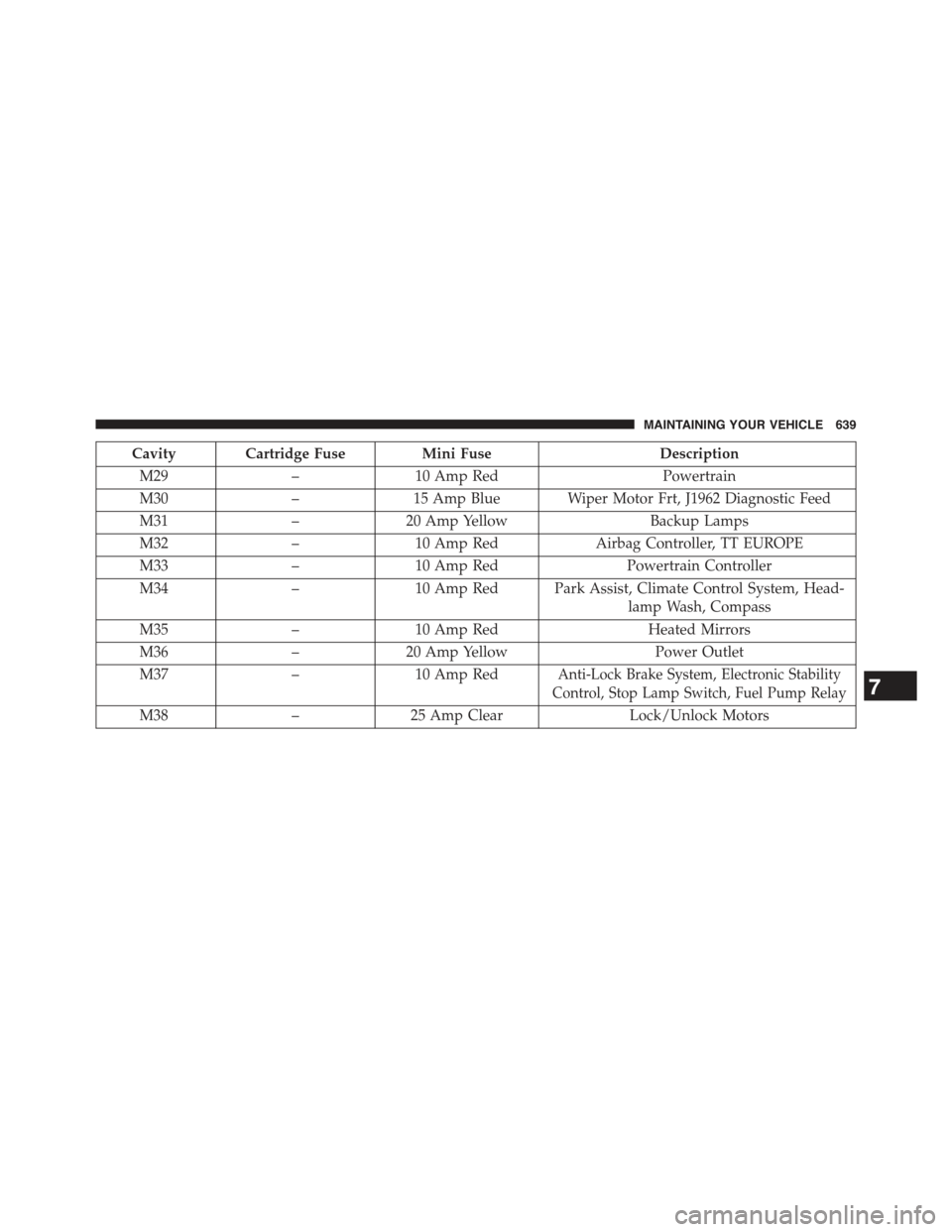
Cavity Cartridge FuseMini FuseDescription
M29–10 Amp RedPowertrain
M30–15 Amp Blue Wiper Motor Frt, J1962 Diagnostic Feed
M31–20 Amp YellowBackup Lamps
M32–10 Amp RedAirbag Controller, TT EUROPE
M33–10 Amp RedPowertrain Controller
M34–10 Amp Red Park Assist, Climate Control System, Head-
lamp Wash, Compass
M35–10 Amp RedHeated Mirrors
M36–20 Amp YellowPower Outlet
M37–10 Amp RedAnti-Lock Brake System, Electronic Stability
Control, Stop Lamp Switch, Fuel Pump Relay
M38–25 Amp ClearLock/Unlock Motors
7
MAINTAINING YOUR VEHICLE 639
Page 642 of 695
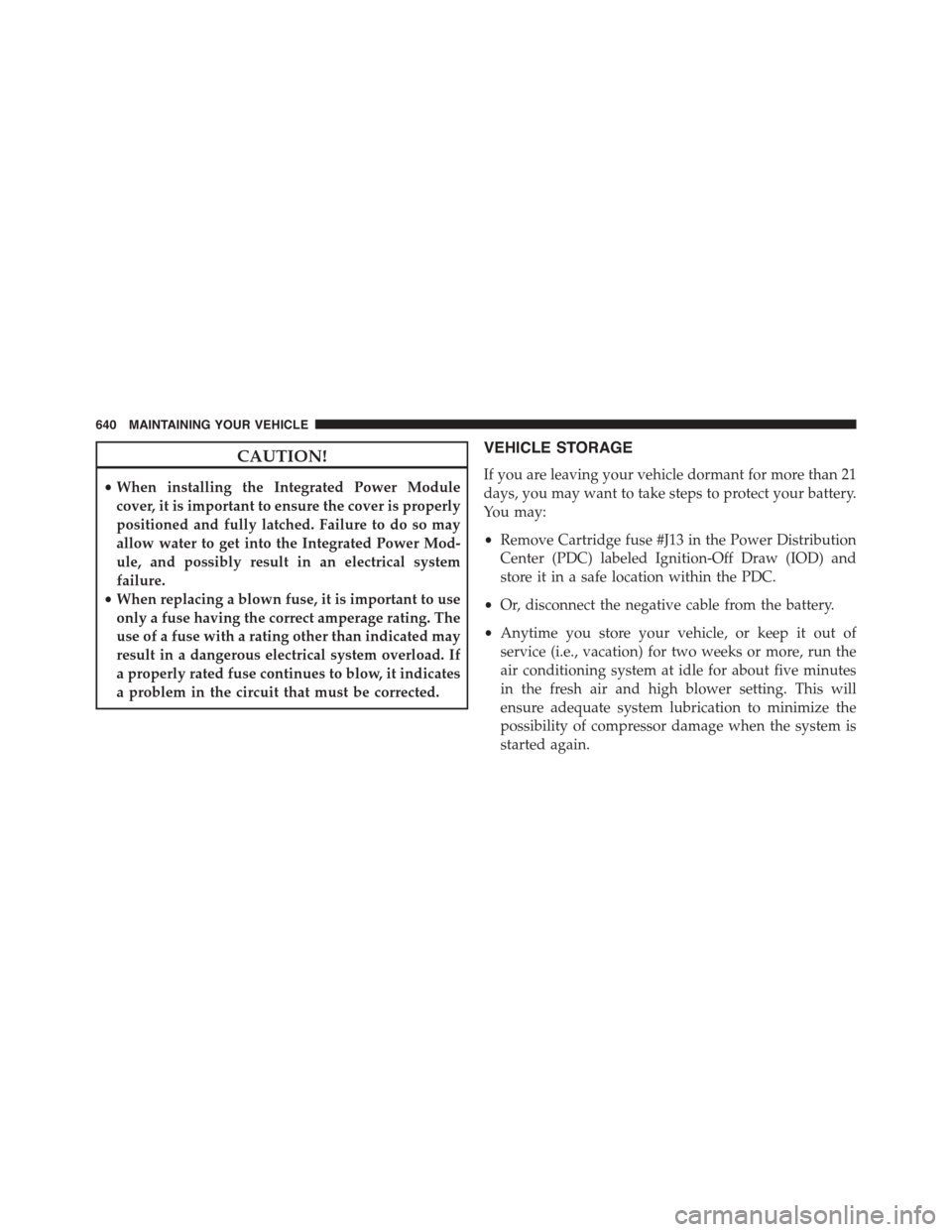
CAUTION!
•When installing the Integrated Power Module
cover, it is important to ensure the cover is properly
positioned and fully latched. Failure to do so may
allow water to get into the Integrated Power Mod-
ule, and possibly result in an electrical system
failure.
•When replacing a blown fuse, it is important to use
only a fuse having the correct amperage rating. The
use of a fuse with a rating other than indicated may
result in a dangerous electrical system overload. If
a properly rated fuse continues to blow, it indicates
a problem in the circuit that must be corrected.
VEHICLE STORAGE
If you are leaving your vehicle dormant for more than 21
days, you may want to take steps to protect your battery.
You may:
•Remove Cartridge fuse #J13 in the Power Distribution
Center (PDC) labeled Ignition-Off Draw (IOD) and
store it in a safe location within the PDC.
•Or, disconnect the negative cable from the battery.
•Anytime you store your vehicle, or keep it out of
service (i.e., vacation) for two weeks or more, run the
air conditioning system at idle for about five minutes
in the fresh air and high blower setting. This will
ensure adequate system lubrication to minimize the
possibility of compressor damage when the system is
started again.
640 MAINTAINING YOUR VEHICLE
Page 643 of 695
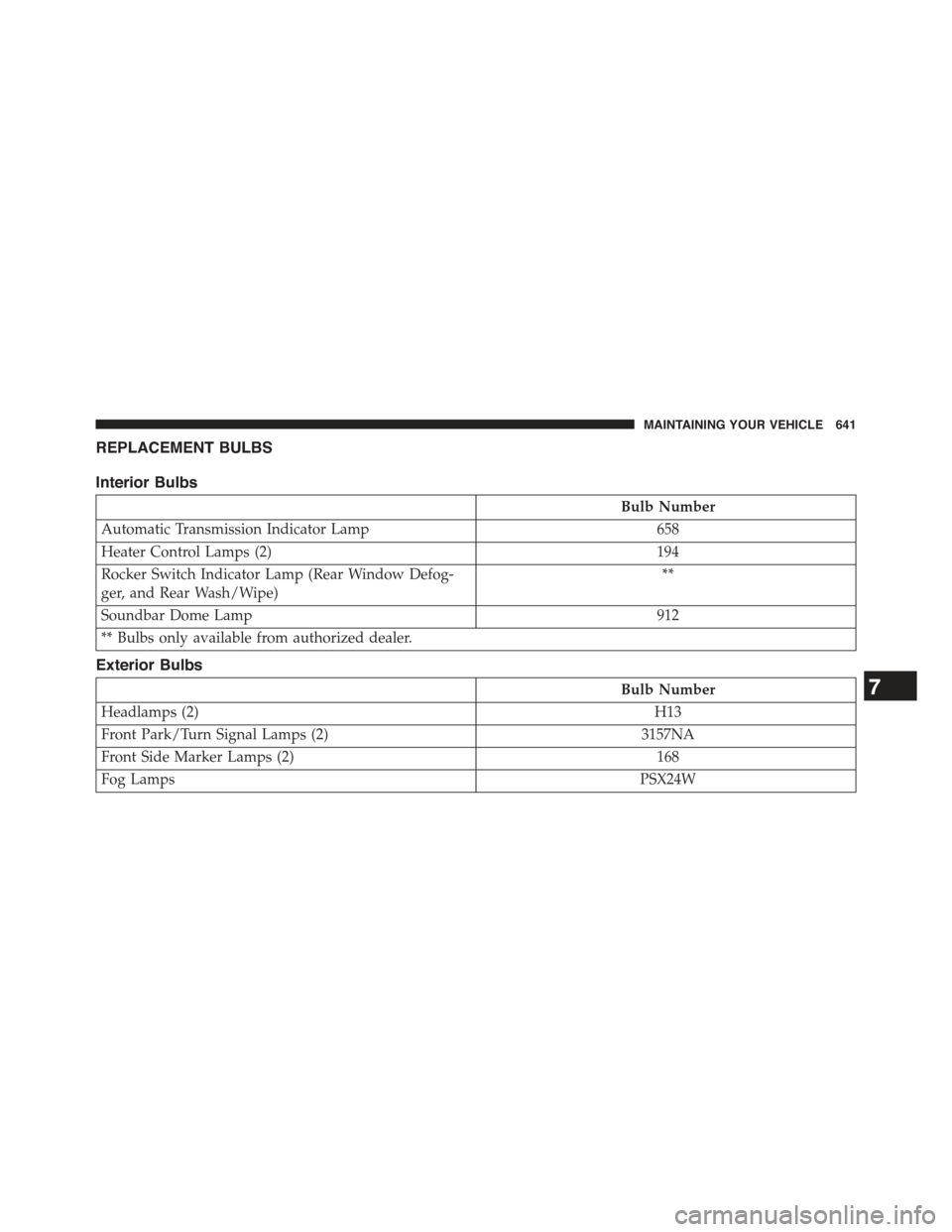
REPLACEMENT BULBS
Interior Bulbs
Bulb Number
Automatic Transmission Indicator Lamp658
Heater Control Lamps (2)194
Rocker Switch Indicator Lamp (Rear Window Defog-
ger, and Rear Wash/Wipe)
**
Soundbar Dome Lamp912
** Bulbs only available from authorized dealer.
Exterior Bulbs
Bulb Number
Headlamps (2)H13
Front Park/Turn Signal Lamps (2)3157NA
Front Side Marker Lamps (2)168
Fog LampsPSX24W
7
MAINTAINING YOUR VEHICLE 641
Page 644 of 695
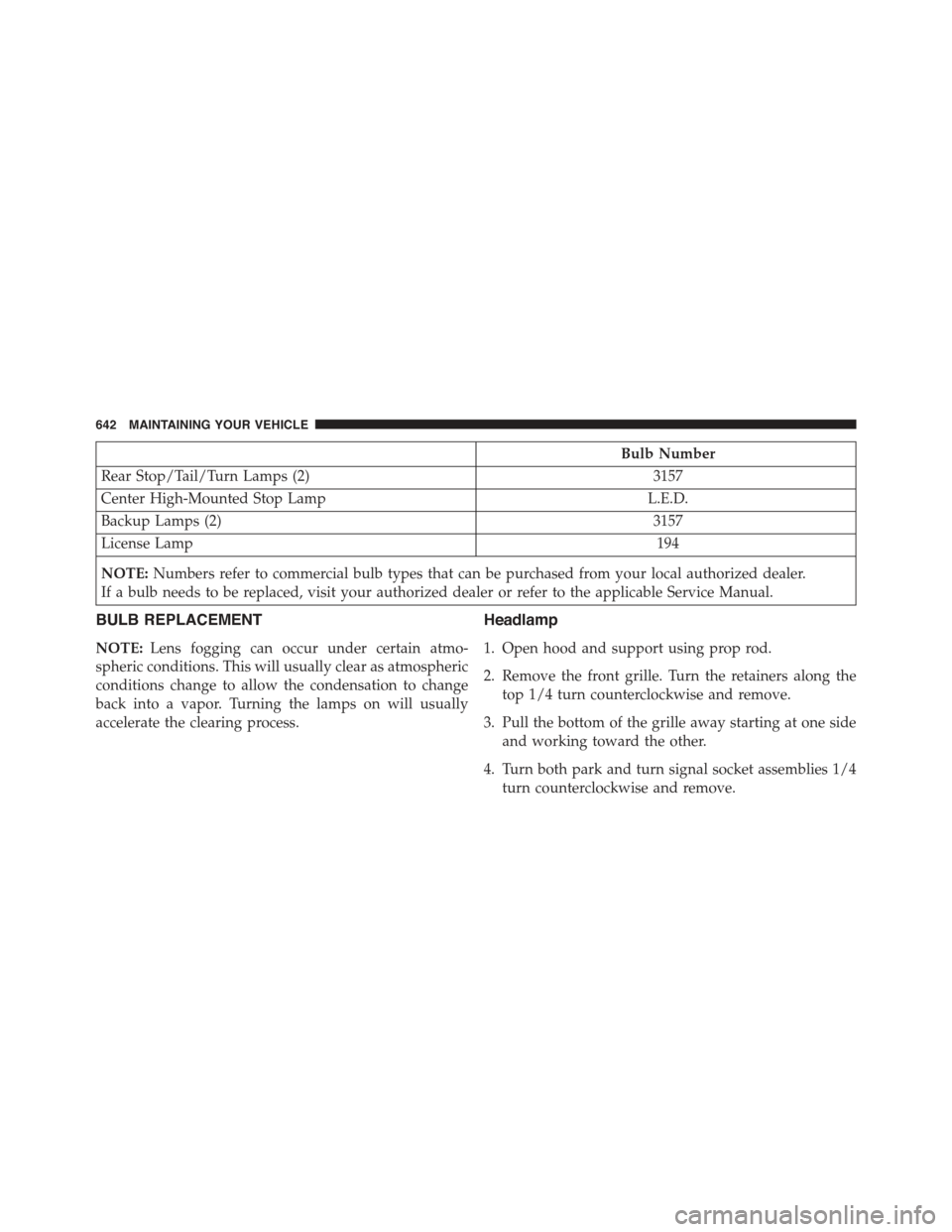
Bulb Number
Rear Stop/Tail/Turn Lamps (2)3157
Center High-Mounted Stop LampL.E.D.
Backup Lamps (2)3157
License Lamp194
NOTE:Numbers refer to commercial bulb types that can be purchased from your local authorized dealer.
If a bulb needs to be replaced, visit your authorized dealer or refer to the applicable Service Manual.
BULB REPLACEMENT
NOTE:Lens fogging can occur under certain atmo-
spheric conditions. This will usually clear as atmospheric
conditions change to allow the condensation to change
back into a vapor. Turning the lamps on will usually
accelerate the clearing process.
Headlamp
1. Open hood and support using prop rod.
2. Remove the front grille. Turn the retainers along the
top 1/4 turn counterclockwise and remove.
3. Pull the bottom of the grille away starting at one side
and working toward the other.
4. Turn both park and turn signal socket assemblies 1/4
turn counterclockwise and remove.
642 MAINTAINING YOUR VEHICLE
Page 645 of 695
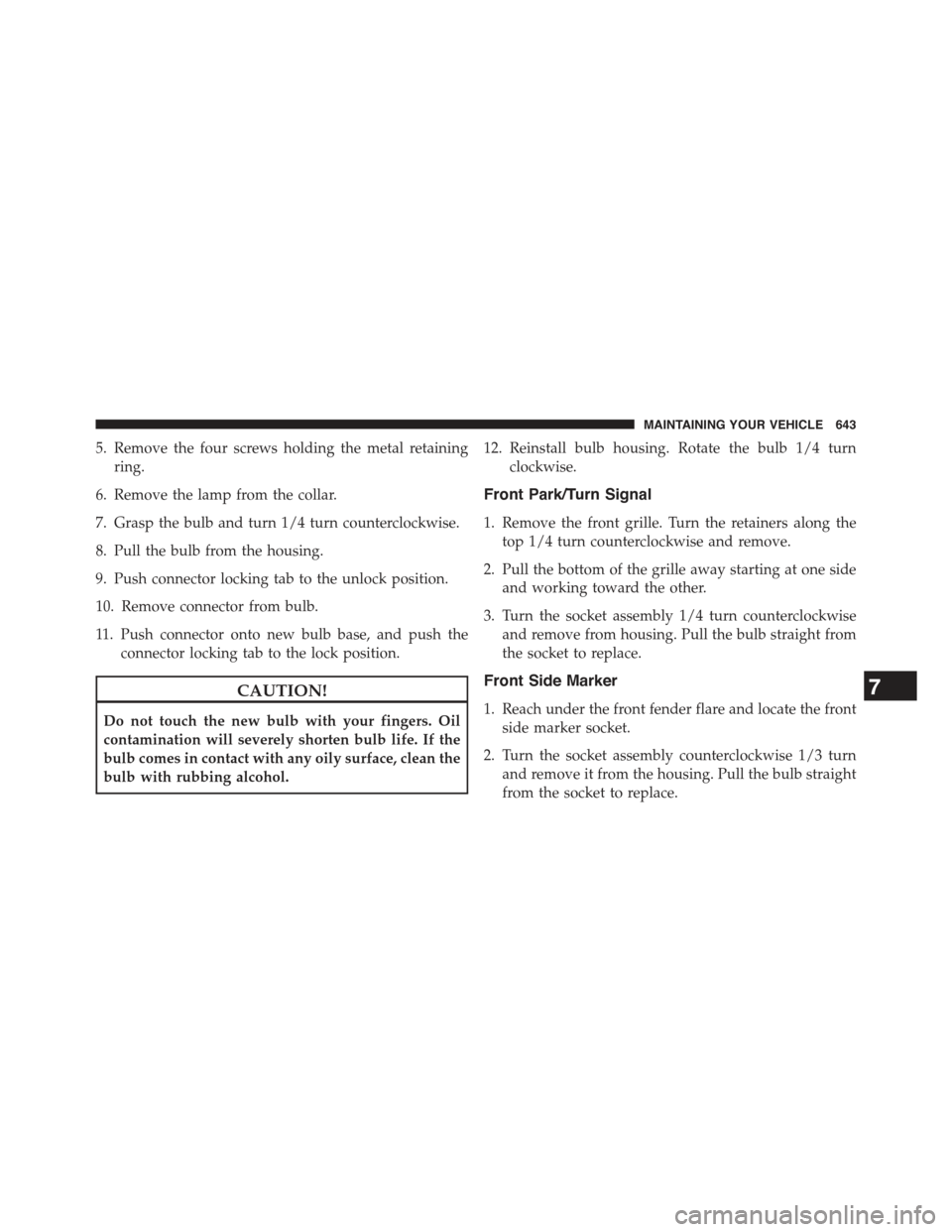
5. Remove the four screws holding the metal retaining
ring.
6. Remove the lamp from the collar.
7. Grasp the bulb and turn 1/4 turn counterclockwise.
8. Pull the bulb from the housing.
9. Push connector locking tab to the unlock position.
10. Remove connector from bulb.
11. Push connector onto new bulb base, and push the
connector locking tab to the lock position.
CAUTION!
Do not touch the new bulb with your fingers. Oil
contamination will severely shorten bulb life. If the
bulb comes in contact with any oily surface, clean the
bulb with rubbing alcohol.
12. Reinstall bulb housing. Rotate the bulb 1/4 turn
clockwise.
Front Park/Turn Signal
1. Remove the front grille. Turn the retainers along the
top 1/4 turn counterclockwise and remove.
2. Pull the bottom of the grille away starting at one side
and working toward the other.
3. Turn the socket assembly 1/4 turn counterclockwise
and remove from housing. Pull the bulb straight from
the socket to replace.
Front Side Marker
1. Reach under the front fender flare and locate the front
side marker socket.
2. Turn the socket assembly counterclockwise 1/3 turn
and remove it from the housing. Pull the bulb straight
from the socket to replace.
7
MAINTAINING YOUR VEHICLE 643
Page 646 of 695
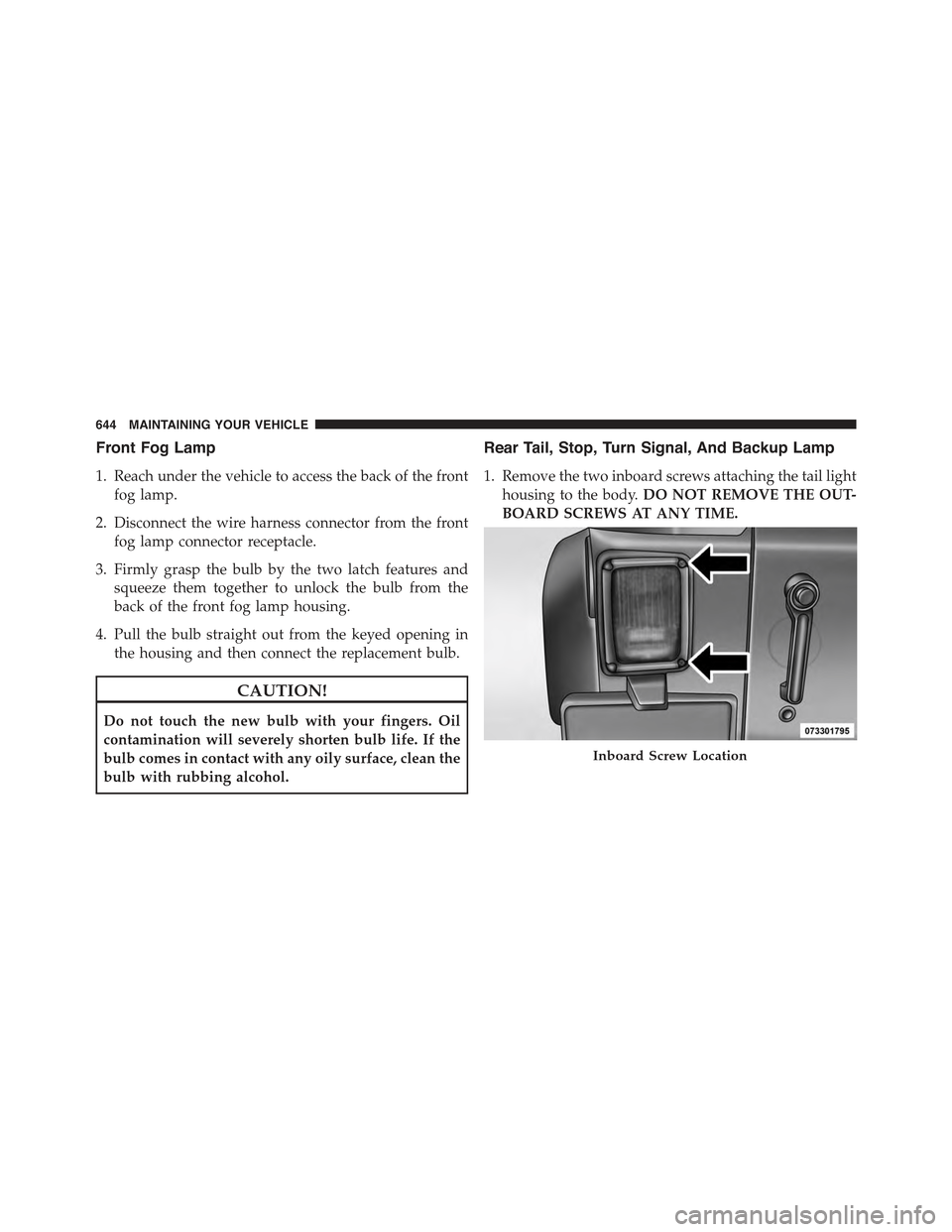
Front Fog Lamp
1. Reach under the vehicle to access the back of the front
fog lamp.
2. Disconnect the wire harness connector from the front
fog lamp connector receptacle.
3. Firmly grasp the bulb by the two latch features and
squeeze them together to unlock the bulb from the
back of the front fog lamp housing.
4. Pull the bulb straight out from the keyed opening in
the housing and then connect the replacement bulb.
CAUTION!
Do not touch the new bulb with your fingers. Oil
contamination will severely shorten bulb life. If the
bulb comes in contact with any oily surface, clean the
bulb with rubbing alcohol.
Rear Tail, Stop, Turn Signal, And Backup Lamp
1. Remove the two inboard screws attaching the tail light
housing to the body.DO NOT REMOVE THE OUT-
BOARD SCREWS AT ANY TIME.
Inboard Screw Location
644 MAINTAINING YOUR VEHICLE
Page 647 of 695
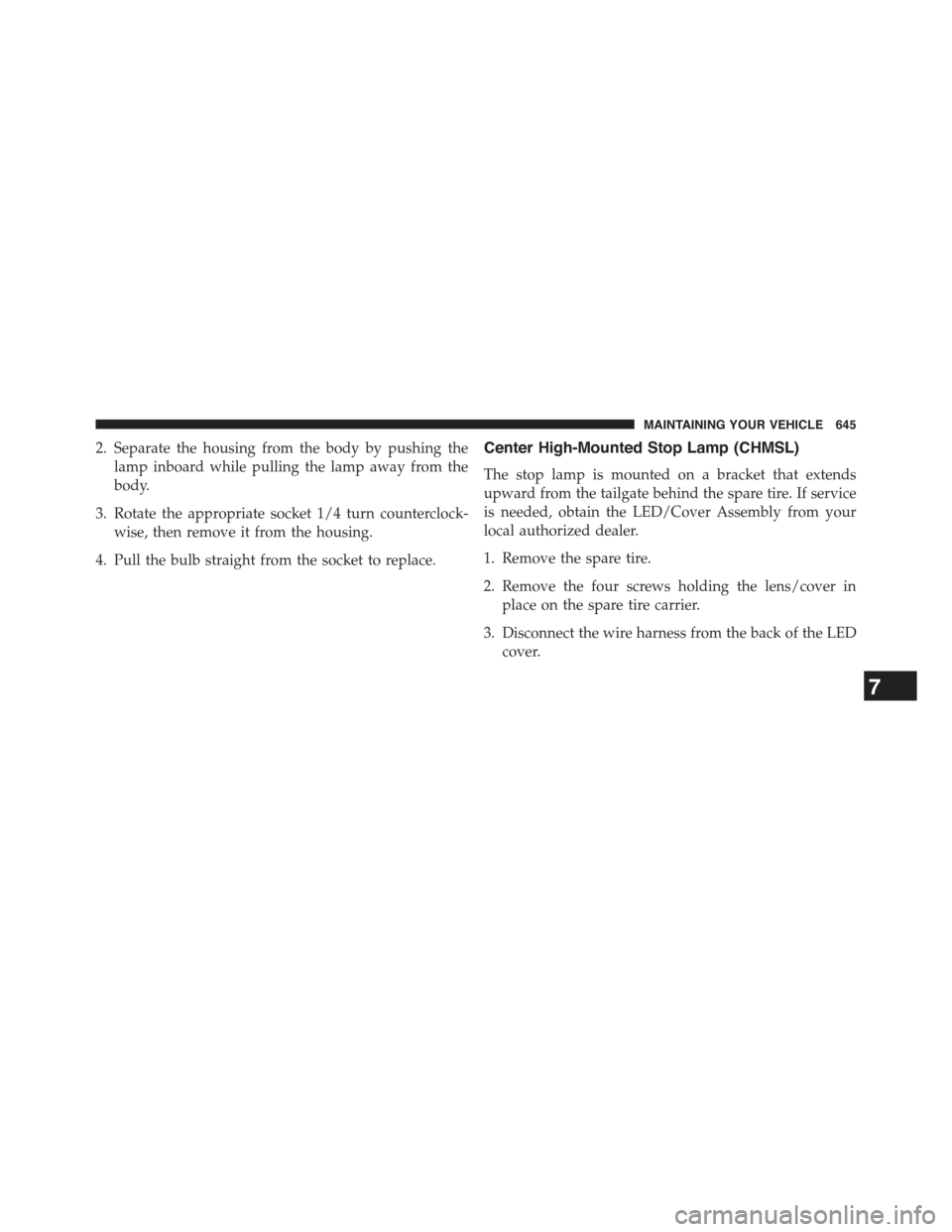
2. Separate the housing from the body by pushing the
lamp inboard while pulling the lamp away from the
body.
3. Rotate the appropriate socket 1/4 turn counterclock-
wise, then remove it from the housing.
4. Pull the bulb straight from the socket to replace.
Center High-Mounted Stop Lamp (CHMSL)
The stop lamp is mounted on a bracket that extends
upward from the tailgate behind the spare tire. If service
is needed, obtain the LED/Cover Assembly from your
local authorized dealer.
1. Remove the spare tire.
2. Remove the four screws holding the lens/cover in
place on the spare tire carrier.
3. Disconnect the wire harness from the back of the LED
cover.
7
MAINTAINING YOUR VEHICLE 645
Page 648 of 695
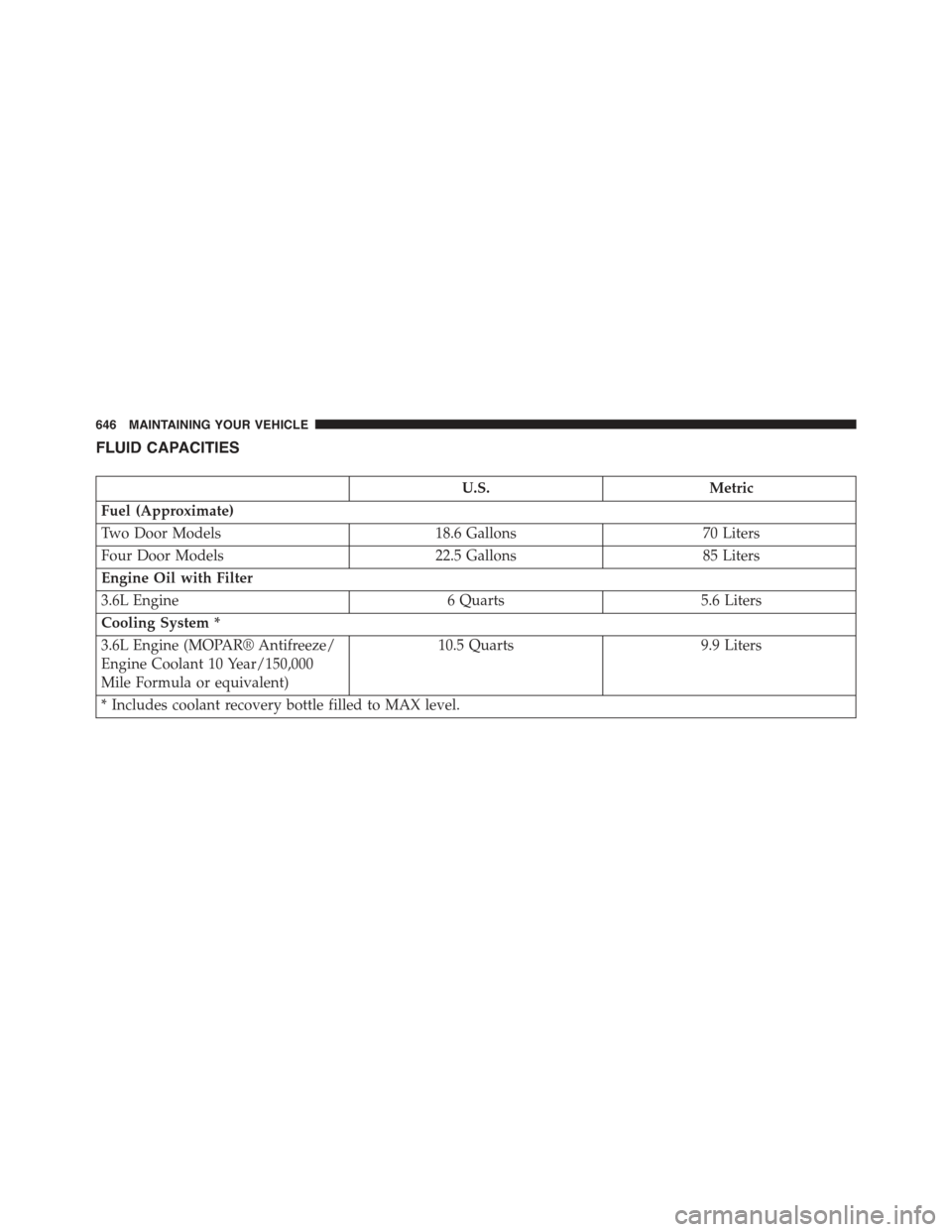
FLUID CAPACITIES
U.S.Metric
Fuel (Approximate)
Two Door Models18.6 Gallons70 Liters
Four Door Models22.5 Gallons85 Liters
Engine Oil with Filter
3.6L Engine6 Quarts5.6 Liters
Cooling System *
3.6L Engine (MOPAR® Antifreeze/
Engine Coolant 10 Year/150,000
Mile Formula or equivalent)
10.5 Quarts9.9 Liters
* Includes coolant recovery bottle filled to MAX level.
646 MAINTAINING YOUR VEHICLE
Page 649 of 695
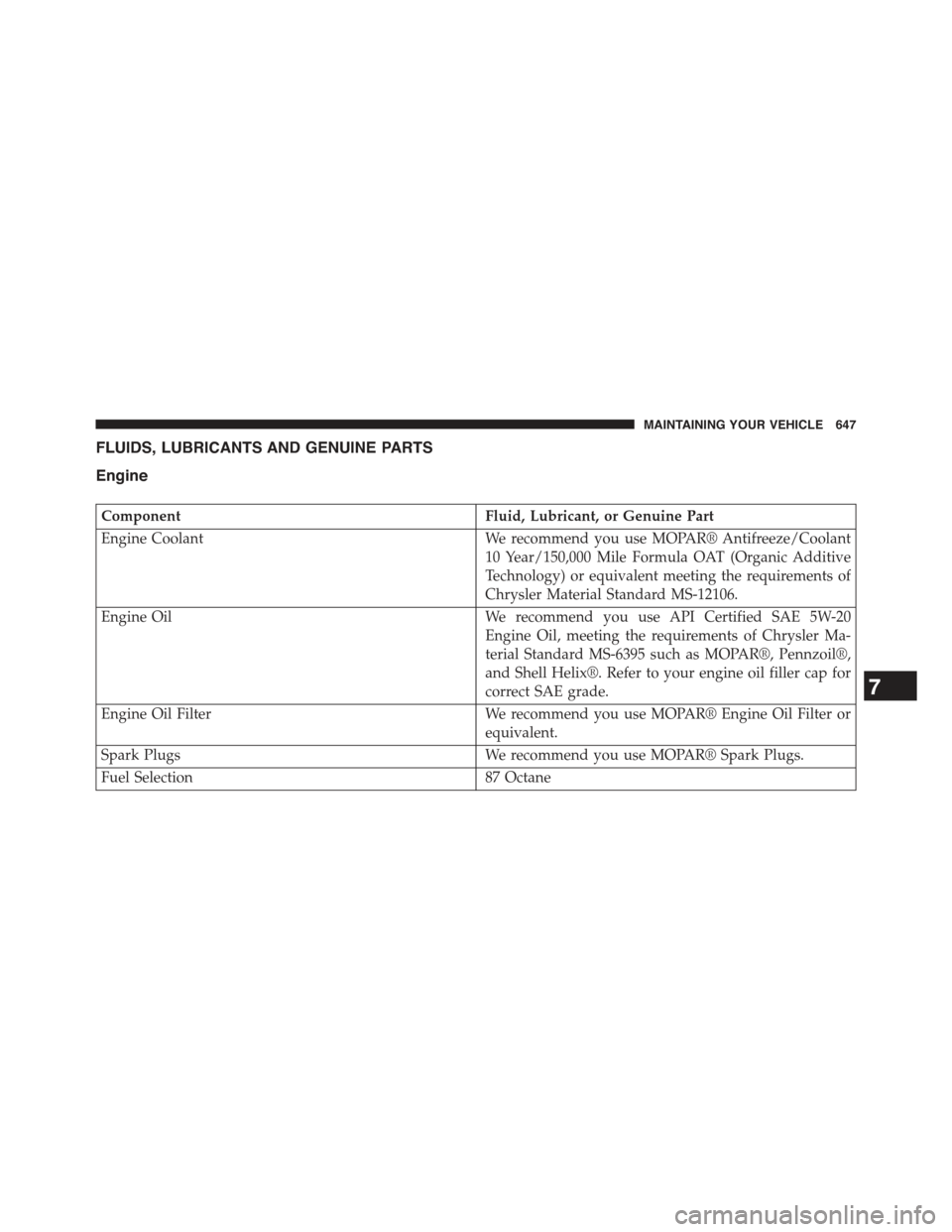
FLUIDS, LUBRICANTS AND GENUINE PARTS
Engine
ComponentFluid, Lubricant, or Genuine Part
Engine CoolantWe recommend you use MOPAR® Antifreeze/Coolant
10 Year/150,000 Mile Formula OAT (Organic Additive
Technology) or equivalent meeting the requirements of
Chrysler Material Standard MS-12106.
Engine OilWe recommend you use API Certified SAE 5W-20
Engine Oil, meeting the requirements of Chrysler Ma-
terial Standard MS-6395 such as MOPAR®, Pennzoil®,
and Shell Helix®. Refer to your engine oil filler cap for
correct SAE grade.
Engine Oil FilterWe recommend you use MOPAR® Engine Oil Filter or
equivalent.
Spark PlugsWe recommend you use MOPAR® Spark Plugs.
Fuel Selection87 Octane
7
MAINTAINING YOUR VEHICLE 647
Page 650 of 695
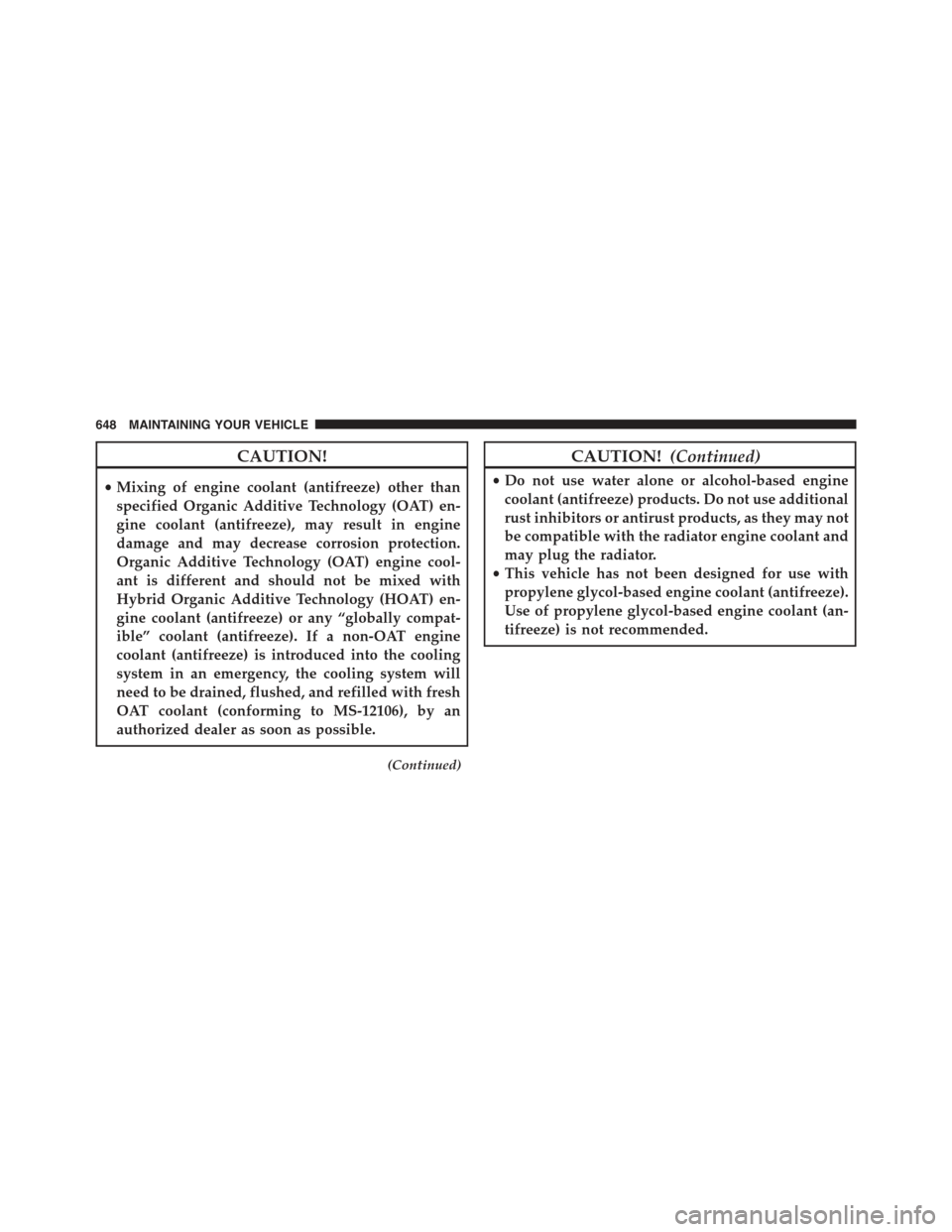
CAUTION!
•Mixing of engine coolant (antifreeze) other than
specified Organic Additive Technology (OAT) en-
gine coolant (antifreeze), may result in engine
damage and may decrease corrosion protection.
Organic Additive Technology (OAT) engine cool-
ant is different and should not be mixed with
Hybrid Organic Additive Technology (HOAT) en-
gine coolant (antifreeze) or any “globally compat-
ible” coolant (antifreeze). If a non-OAT engine
coolant (antifreeze) is introduced into the cooling
system in an emergency, the cooling system will
need to be drained, flushed, and refilled with fresh
OAT coolant (conforming to MS-12106), by an
authorized dealer as soon as possible.
(Continued)
CAUTION!(Continued)
•Do not use water alone or alcohol-based engine
coolant (antifreeze) products. Do not use additional
rust inhibitors or antirust products, as they may not
be compatible with the radiator engine coolant and
may plug the radiator.
•This vehicle has not been designed for use with
propylene glycol-based engine coolant (antifreeze).
Use of propylene glycol-based engine coolant (an-
tifreeze) is not recommended.
648 MAINTAINING YOUR VEHICLE